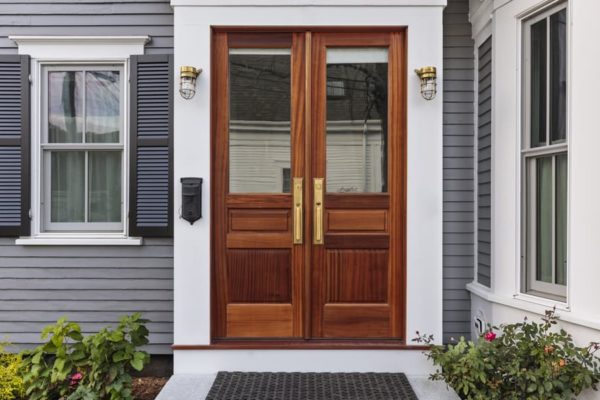This post will explain what is brickmold. The first thing somebody sees when they visit your home, besides the general look, is the front entryway. It’s vital to ensure that your front entryway is presentable and addresses your taste along these lines.
While you can do a few things to amp up an entryway, confronting is probably the simplest way. Confronting can go on any entryways, thus can a mainstream kind of confronting called brickmould. This sort of meeting is acclaimed on purpose.
What Is Brickmold For Exterior Doors?
In this article, you can know about what is brickmold here are the details below;
What Is Brickmold?
Investigate a couple of front entryways, in actuality and on the web. Odds are, on more than one of them, there is a casing around the entryway. This casing is known as brickmold. It fills some needs, from feel to weatherproofing.
Not all brickmold is something very similar, however. There are different materials, shadings, and thicknesses. There are even different plans on some brickmolds. So you can’t just request brickmold without understanding what you need.
Is Brickmold Made Of Brick?
The short answer is that “no” brickmold isn’t made of block. Despite the name, the brickmold is made of different materials, which we will speak more about later. Rights now, you might be asking why it is called brickmold.
While nobody knows where the term brickmold came from, it tends to be accepted the names come from the siding it covers. Brickmold was made to secure the block around windows and entryways. In this way, the expression “brickmold,” was conceived.
Brickmold Door Vs. Entryway Without Brickmold
Not all entryways have brickmold. Some do, some don’t, yet which is better? While everybody has their inclination, we can separate a couple of central issues to help you choose which one is better for you.
Solidness
Adding a layer to your door jamb can make it more sturdy. There is one additional layer for things to get past, so the actual entryway will last more. This one is a given, and brickmold wins without any problem.
On the off chance that the brickmold is builtin, it will be much more solid since it made it one piece. They weren’t at first; however, the brickmold, for this situation, will be secure and offer a great deal of assurance.
Strength
Security and solidness are two distinct things for this situation. On the off chance that you have pets, you know whats this implies. Canines are pulled into things likes brickmold and will continually bite on the base. This leaves you with a revolting casing.
In any case, it isn’t simply pets. The lower part of brickmolds can get filthy and turn out to be difficult to clean. This does your entryway look ugly and grimy by and large, definitely not something to be thankful for. You should clean it as often as possible.
Climate
Since there is a joined layer, having brickmold can keep your door jamb from getting wet and your pivots from rusting. In any case, brickmold will be unable to deal with solid breezes, and this will require fixes.
Regardless of whether you shield metals from rust, wood on the brickmold can form. You can figure out how to eliminate shape from wood, yet any sort of form isn’t ideal to have around.
Security
On the off chance that you were a cheat and saw two entryways, one with brickmold and one without brickmold, which would you decide to burglarize? The one without brickmold. Although it isn’t actually for this, brickmold can deflect hoodlums.
Regardless of whether one chooses to pull out all the stops, taking the brickmold off, regardless, can take longer and give you additional time. The brickmold may not cover the locks, yet it can secure admittance to them.
Cost
Another undeniable success, however, for no brickmold. Adding brickmold adds another expense. Notwithstanding, this is the forthright expense, and it isn’t known whether you will set aside cash later on for having brickmold security.
There is a decent possibility that supplanting your entryway sooner will cost more than the forthright expense of getting one with brickmold. In any case, this hasn’t been demonstrated or concentrated with the goal that it will be dependent upon the situation.
Style
This might be the most fundamental interesting point. Simultaneously, these different things can be significant. The way that brickmould looks should take need. It might be ideal if you settle on your choice, dependent on which one you like the vibe.
No brickmold can look present day and straightforward. However, it can likewise look vintage. On the other hand, brickmold entryways can look bungalow-like or contemporary because of the mathematical state of the brickmold.
Brickmold Materials
Although brickmold isn’t made of block, it isn’t constantly made of similar material by the same token. There may not be a wide assortment of genuine brickmold at present. However, there are choices, so you’re not secured in one kind.
Wood
There are two sorts of wood brickmold. There is softwood, which turns out great for inside, and hardwood, which is suggested when utilizing wood outside. Hardwood brickmold is flawless and solid.
Vinyl
Vinyl is quite possibly the most mainstream sorts of brickmold, and it can work for any sort of entryway. It is moderate and simple to discover. Vinyl brickmold is not difficult to work with and is generally white. Be that as it may, it tends to be found in different tones.
PVC
PVC is very much like vinyl and can be found at similar stores. It works incredibly outside on outside entryways and is weatherproof. PVC is regularly prescribed for front entryways because of the sturdiness of it on brickmolds.
Metal
Not all metals are made equivalent. While more crucial metals are huge for different purposes, metals like aluminum function admirably for brickmold. Although not as regular as vinyl, wood, or PVC, a metal brickmold is accessible.
Picture from Massucco Warner Miller Interior Design
On the off chance that you are purchasing another entryway yourself and need to introduce it yourself, at that point, bravo. Here are the essential advances you can take to introduce an entryway that comes total with an edge and trims or confronting.
Measure Space
The initial step is to gauge the entryway or space you have. On the off chance that you are building a house, check the section you need to utilize. On the off chance that you are supplanting an old entryway, measure the zone after you eliminate the old entryway.
Make The Frame (if new casing)
If you are working without any preparation or adding another entryway, you’ll need to make a casing. This is a unique guide, yet it isn’t too troublesome. The main part is to ensure each of the four sides is level.
Test The Size
If this is another edge, you need to test the size before focusing on setting the entryway. It’s OK if there is a smidgen of room. This is ordinary. Yet, don’t pound the entryway in, or probably you could break the glass.
Adapt
On the off chance that you discover that your door jamb is excessively huge, add two-by-fours or change the ones you have. On the off chance that it is excessively little, you’ll need to extend the casing with a saw and add the two-by-fours back for the edge.
Apply Caulk
When you’re certain the fit is correct, apply caulk to where the entryway will go. This isn’t for lastingness, and it’s so the entryway will stick while you’re chipping away at it and will have weatherproofing in places you can’t arrive at later.
Shim
Shimming is a procedure used to add backing to an entryway and keep things stable. They fill minuscule holes that are important to fit the entryway. You can purchase wooden shim sheets at a small cost. Get a lot of them.
Screw Frame In
It’s a smart thought to tighten the casing now. You can do transitory anchors or do the last screws. When you do the last screws, try to do as numerous as the producer recommends. Simply don’t put so numerous that you break the casing.
Introduce Hinges
After you screw the edge in, you can introduce pivots in the entryway if they aren’t now in. Eliminating the entryway before sinking the edge is a smart thought on the off chance that you previously tried the way to ensure it fits right.
Caulk The Gaps
Caulk around the entryway between the shims. You don’t need any air to discover its way through the holes, so do this part well overall. Try not to pack yet ensure you cover each inch for the best outcomes.
Cut The Shims
Presently you can cut every one of the shims, so they are flush with the edge. You need them to be level so you can apply the confronting later. You can either utilize a blade or a Sawzall to do this.
Apply Facing
This is the place where you apply the confronting or the brickmold. Use finisher nails for the inside and screws for the outside. You can normally leave one nailed if you have a set. This will keep the entryway stable while working at any rate.
Introduce Lock
At long last, introduce the new equipment, including the door handle and lock. You may make them change and testing to do before you can consider it daily. However, this will be your last advance. You’ve recently introduced your first front entryway!
Isn’t It Called Brickmould?
Indeed, brickmould is the first method to spell it, and it is the current UK spelling. However, since “shape” is spelled “form” in American English, brickmould was changed to brickmould for American English.
The amount Does Brickmold Cost?
Getting brickmould will add about $100 to $150 to the front entryway’s establishment and material expense. This can wind up being somewhere close to $400 and $1200 altogether, contingent upon work and the sort of entryway you pick.
How Wide Is Brickmold?
Although you can get custom sizes and different set sizes, most brickmold is somewhere in the range of 2 and 4 inches. Any more thorough, and it will be excessively flimsy and could break. Any lighter, and it will not offer any of the advantages it ought to.
Would I be able to Get Brickmold Already Built-In?
Indeed. Nowadays, most outside entryways and numerous inside entryways accompany a door jamb, and brickmould worked in. This doesn’t add to the entryway’s expense because most entryways will come this way if they are new.
Do I Need Briclmold?
No, you don’t require brickmold. In any case, it is prescribed because of the additional security it offers. It is difficult to weatherproof an entryway without a brickmold, and it can leave an entryway looking incomplete, very much like the absence of a trim can.

